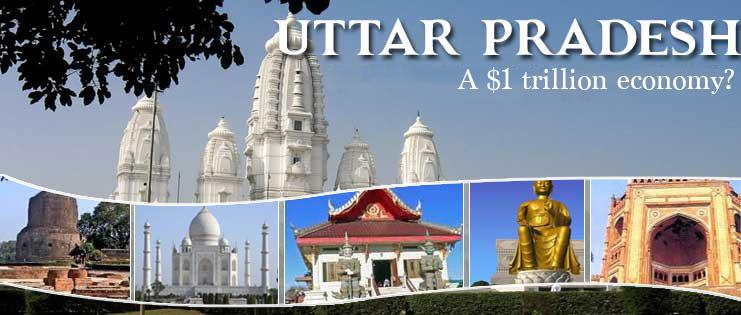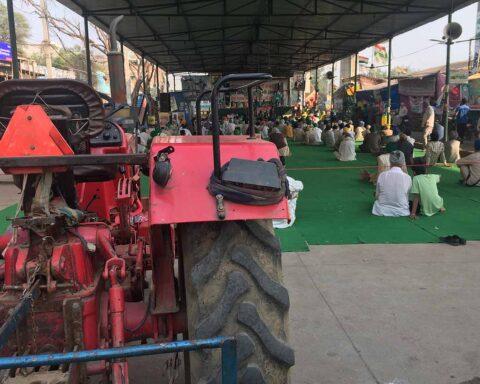Can Uttar Pradesh (UP) become a trillion-dollar economy by 2027-28, as Chief Minister Yogi Adityanath proclaimed in June? UP’s gross domestic product was $250 billion in 2021-22 at current prices. To meet the goal, the state’s economic output will have to grow four-fold, or 400%, in six years. Something unheard of, economically.
It begs a natural question about how UP’s economy has fared in the recent past.
Since Adityanath became chief minister in 2017, at constant prices, by 2021-22, UP’s economy expanded by 6%. Other states have done better. Madhya Pradesh’s economy grew by 25%, Bihar’s by 24%, Rajasthan’s by 17%, Himachal’s by 14% and Jharkhand’s by 12%. During this period richer states have done well too. Andhra Pradesh’s economy was 27% larger than in 2017-18, Karnataka’s 23%, Telangana’s 21% and Tamil Nadu’s 19%.
UP’s economic output divided by its population, or per capita net state domestic product (NSDP), contracted during the five years under review. It shrank by 3%, or ₹1,339, to ₹40,432 in 2021-22. The Covid pandemic seems to have hit it hard. In 2019-20, its per capita NSDP had risen to ₹43,053. But a harsh lockdown followed in March-May 2020, and migrants, on which UP is dependent, returned to their villages in droves owing to lack of jobs in the cities. Another state that saw a decline in per capita NSDP was West Bengal—by 1%. But Bihar which also has a large migrant population like UP and West Bengal, saw per capita NSDP grow by 15%.
The latest Periodic Labour Force Survey (PLFS) conducted between June 2022 and July 2023 shows post-pandemic recovery. UP’s unemployment rate is 3.7% compared to the all-India average of 5.1%.
But the quality of employment is rather poor. Among those employed, 67.7% were into self-employment and 21.9% did casual labour—higher than the national average, while a lower proportion had regular wage or salary employment.
Despite this, UP has been literally glowing at night. Total night-time radiance showed a 69% increase between 2015 and 2019, according to the Bharti Institute of Public Policy (BIPP) of the Indian School of Business (ISB). Data captured by satellites showed that 389 of the state’s 403 assembly constituencies had an increase in total radiance.
Night life
Night-time radiance is a good measure of economic activity, especially in manufacturing and services. Of course, not all factories work night shifts. An increase in agricultural activity might not show up in radiance as pumps do not throw up light. But increased incomes mean better lit homes (if there is access to electricity and regular power supply) and enhanced commercial activity. According to BIPP’s analysis, 17% of UP’s constituencies showed a large increase in total radiance, 52% a moderate increase and 27% a small increase.

Another measure that BIPP considered was ‘lit pixels’, which shows the spread of economic activity over time. There was a large increase in lit pixels in 17% of the constituencies and a moderate to small increase in 72.5%.
As per Central Electricity Authority (CEA) data, UP’s power consumption increased by 42% between 2014-15 and 2019-20 from 74,898 million units (MU) to 105,652 MU (a unit is one kilowatt of electricity consumed in one hour). It declined by 602 MU the following year when the pandemic disrupted commercial and industrial activity. The share of homes in UP’s total electricity consumption rose from 33% to 40% and the total units they consumed increased by 69%.
Commercial consumption went up by 55% as did power use by the farm sector, but this will not result in increased radiance. Industrial consumption, on the other hand, was virtually flat. It inched up by just 2.5% from 26,375 MU in 2014-15 to 27,023 MU in 2019-20. The following year, it declined by 733 MU because of the pandemic. Better domestic access to electricity and improved supply seem to be the main reasons for the increase in night-time radiance.
How is it possible for home power consumption to rise if industrial activity is flat? One factor is remittances sent by migrants. A rise in government spending might be another. Improved farm incomes could be a third.
Industrial sector performance
Within the rather flat industrial sector, the sugar industry has done well. UP was the largest producer of sugarcane. But its sugar recovery rate used to be lower than that of Maharashtra. A high-yielding sugarcane variety called CO 0238 introduced in 2012-13 raised the state’s sugar production from 71 lakh tonnes in 2014-15 to 120 lakh tonnes (before diversion of some quantity for ethanol production). The state’s installed sugar production capacity more than doubled from 71 lakh tonnes a year in 2014-14 to 153 lakh tonnes.
The distillery sector also got a boost from the Centre’s programme of blending petrol with ethanol. According to a Central government press release, UP had 58 molasses-based distillery projects as of December 2022 with an installed capacity of 205 crore litres, next only to Maharashtra which had 116 projects capable of producing 225 crore litres of ethanol. The ethanol offtake of the oil marketing companies has increased from 67 crore litres in 2014-15 to 158 crore litres in 2019-20. UP has a significant share in it. The resultant improved profitability of sugar mills would reflect with sugarcane farmers.
But some industries have taken a hit. When Adityanath became chief minister in 2017, he ordered closure of abattoirs that did not meet pollution control norms.
Most of them did not and they were municipal owned. According to the United States Department of Agriculture (USDA), India’s carabeef, or buffalo meat, exports declined from 1.79 million tonnes in 2017 to 1.44 million tonnes in 2022. UP’s export of the product would have declined because of aggressive vigilante activity, which has made cattle transport and trading difficult. UP accounts for 30% of the country’s buffalo population.
The leather industry has also suffered collateral damage. The country’s leather exports fell from $6.50 billion in 2014-15 to $4.87 billion in 2021-22. The leather industry is labour intensive. The 2016-17 Economic Survey said India should promote exports of leather goods because footwear making produces 7.7 jobs and leather goods 9.9 for every ₹1 lakh of investment compared to 0.3 jobs in the auto sector and 0.1 in steel making. Of course, the decline in leather exports is not entirely due to unfavourable policy. There is a global trend towards non-leather footwear and goods.
Has the Adityanath government given a boost to the dairy sector? The state’s milk production in 2021-22 was 13.6% more than in 2017-18, or 33 million tonnes. But Rajasthan’s output grew faster at 48% and the output was slightly higher than that of UP. Bihar’s milk production also grew faster at 25%, reaching 12 million tonnes.
At the June meeting, the chief minister told officials to focus on promoting manufacturing, information technology and information technology enabled services, religious tourism, and agriculture. He said special attention should be given to energy, urban development, and food processing.
Foreign direct investment
UP ranks low in foreign direct investment, which flows mainly into financial services, information technology and scientific research and development. Whatever FDI it gets in these categories is confined to areas close to Delhi, like Noida. Noida sparkles, literally. Its total radiance in 2020 was 36,719 pixels. Adjoining Dadri, Jewar and Ghaziabad followed at some distance as did Gowardhan (near Mathura) and two constituencies of Lucknow (15,577 and 18,274 pixels). In much of the state, total radiance is below 5,000 pixels.
But UP will gain from Central government benevolence. A defence technology and defence testing centre are to be located near Lucknow, where the BrahMos cruise missiles will be made. A medical device park is to be set up in Gautam Budh Nagar, the district adjoining Delhi. Noida is to be developed as an international film city and Greater Noida as a data centre hub. Software parks are being developed in Kanpur, Lucknow, Allahabad, Noida and Meerut, says a government advertisement. A 1,000-acre textile park is to come up between Lucknow and Hardoi and flatted factory complexes are to be set up in Agra, Kanpur and Gorakhpur. Industrial corridors will be established along highways and expressways.
All this will be in the future. It reminds one of the period before liberalisation, when the government set up industries in backward areas or directed private investment to them with subsidies. But the true test of a state’s investment quotient is its innate attraction for private investors. For that, UP will have to compete with states that have had a head start.


























